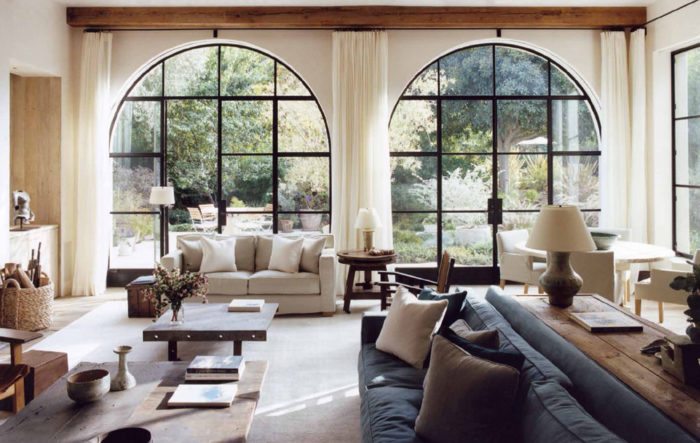Do Mix Wood Finishes:
A little worried about your dark espresso floorboards competing with your raw timber kitchen island and bleached table? Don’t be – follow the lead of Belgian architects who mix and match all kinds of different timber types, stains and finishes in a room. The ‘collected look’ is far more natural and less contrived than if everything is a perfect match.
Do Hang Curtains And Blinds In The Same Room:
It’s more important to consider what will work best for the shape and position of each window than to ensure your entire room has matching window treatments. Try using the same shade or fabric to create a cohesive look.
Do Try Unusual Furniture Plans:
If a living room full of armchairs is better suited to the way you live than a sofa and coffee table, use them. If you’d like a chaise and bookcase in the dining room, go ahead. If it works for you, it works.
Do Opt For No Rug:
If you are fortunate enough to have fabulous timber flooring or just don’t like the look or feel or a floor rug – forget it. Some of the best interiors in the world feature bare boards.
Do Mix Dramatically Different Styles:
Not too sure about teaming Aunt Tiffany’s walnut dresser with the new-designer marble table and Perspex lamps you’ve been coveting? A dramatic mix of periods, styles, looks, and materials is key to creating a personal environment that reflects ‘you’. Don’t worry about what the neighbours think – the most successful interiors are a mix of cherished heirlooms, saved-for pieces, and bits bought from the heart all put together by the same ‘eye’.
Don’t Dump A Single Bunch of Flowers In A Cylindrical Vase:
There’s nothing more unimaginative. Flowers don’t grow straight in nature, so they need a vessel with a wide opening that allows them to tilt and cross over. The vase is vital. Start building up a good collection of non-cylindrical vases: jars, jugs, low open bowls, sugar basins, tureens, urns, teapots, and match your flowers to receptacle. Then grab a few pretty leaves from the garden: foliage is the cheapest and chicest decorating accessory. And place on your desk or side table.
Don’t Let Your Rugs Float:
If you’re stuck with a small rug, don’t let it fly solo in the middle of the room. Ground it by placing it under furniture, whether under your coffee table or one foot of your sofa. Now.
Don’t Overdoing The Lighting:
You want your lights to flatter you and your home, not show up every stain and wrinkle. Soft lighting is magic. That’s why so many proposals are made over candlelit dinners.
Don’t Push Your Furniture Out To The Walls:
However big or small your space, don’t put seating around the edge of a room. It can look like a doctor’s waiting room or railway station. The space will seem bigger, and more welcoming, if you have space around the walls. And don’t use too many single chairs. The room will seem formal and unwelcoming.
Don’t Create Dead Zones:
The real test of a room’s success is whether you spend time in it. If a room never gets used, change its function.
THE BIGGEST DECORATING NO-NOS :
Not Fluffing Your Pillows: We agree pillows are to be used, but once you are finished sitting (or lying) on them, bring them back to life with a good puff. A well-fluffed pillow will make your space look top-notch instantly.
Not Being Organized: Good organisation is invisible. Muddle stares you in the face. Be on constant patrol to keep stuff out of your house. Curating your bits and pieces will keep you from looking like a hoarder. If things have a proper home they are more likely to be put away.
Not Hanging Art: Don’t leave unframed art leaning on floors for years. Frame the best and chuck the rest. Hang your art at the right height: the general rule is to make sure the centre of the work is 150cm from the floor.


